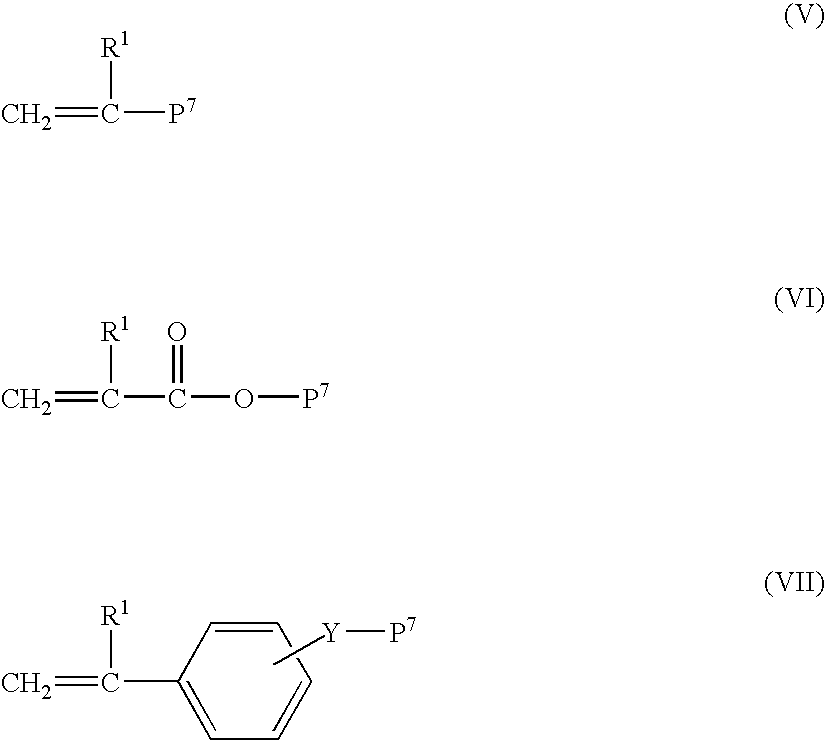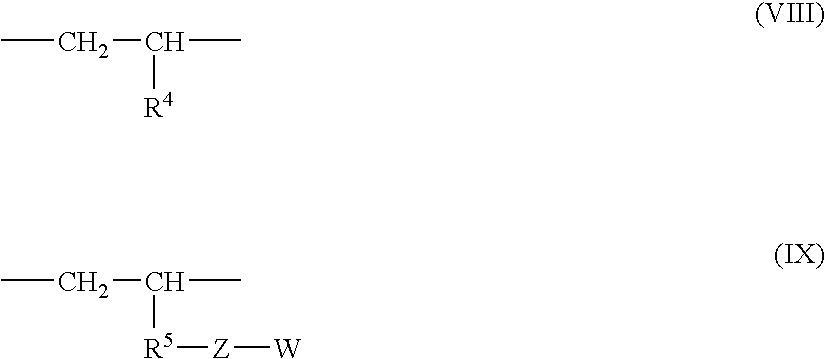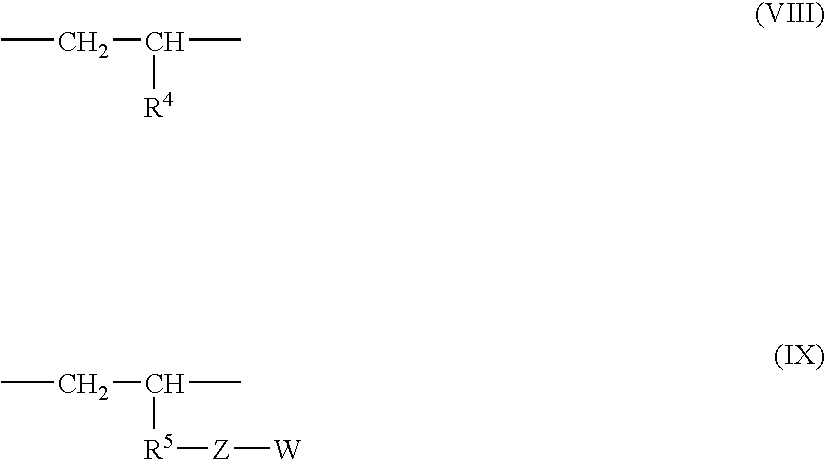Multi-branched polymer, process for producing the same, and applications thereof
- Summary
- Abstract
- Description
- Claims
- Application Information
AI Technical Summary
Benefits of technology
Problems solved by technology
Method used
Image
Examples
example 1
(1) Synthesis of Macromonomer
[0683] [Synthesis of an Ethylene-propylene Copolymer (EPR) Whose Terminal was Converted Into Al]
[0684] 800 ml of purified toluene was introduced into a glass autoclave with an internal volume of 1 liter purged sufficiently with nitrogen, and the liquid phase and gaseous phase were saturated by blowing 20 liters / h ethylene and 80 liters / h propylene. Thereafter, MAO in an amount of 20 mmol in terms of Al and 0.02 mmol of dicyclopentadienyl zirconium dichloride were added at 50.degree. C. to initiate polymerization. After polymerization at normal pressure at 50.degree. C. for 120 minutes, a small amount of isobutyl alcohol was added to terminate the polymerization. The reaction solution was washed 5 times with 100 ml of 1 N aqueous hydrochloric acid solution and 2 times with 100 ml of water, and the organic layer was dried with magnesium sulfate anhydride and filtered through a glass filter (G3) to remove the magnesium sulfate. The filtrate was concentrated...
example 2
[0698] (1) Synthesis of EPR Macromonomer
[0699] 250 ml of purified toluene was introduced into a glass autoclave with an internal volume of 500 ml purged sufficiently with nitrogen, and the liquid phase and gaseous phase were saturated by blowing 40 liters / h ethylene and 60 liters / h propylene. Thereafter, MAO in an amount of 12.5 mmol in terms of Al and 0.05 mmol of bis(1,3-dimethylcyclopentadienyl) zirconium dichloride were added at 60.degree. C. to initiate polymerization. After polymerization at normal pressure at 60.degree. C. for 180 minutes, a small amount of isobutyl alcohol was added to terminate the polymerization. The reaction solution was washed 5 times with 200 ml of 1 N aqueous hydrochloric acid solution and 2 times with 200 ml of water, and the organic layer was dried with magnesium sulfate anhydride and filtered through a glass filter (G3) to remove the magnesium sulfate. The filtrate was concentrated, and the resulting oily matter was dried under vacuum for 10 hours t...
example 3
(1) Synthesis of Hydroxy-containing Polyethylene (PE)
[0702] [Synthesis of an Ethylene / 10-undecen-1-ol Copolymer]
[0703] 900 ml of toluene was introduced into a 1-L glass polymerizer purged with nitrogen, and while an ethylene gas (100 L / h) was circulated, 5.0 ml (5.0 mmol) of stock solution (1.0 M toluene solution) of triethyl aluminum and 0.80 ml (4.0 mmol) of 10-undecen-1-ol were added thereto, and the mixture was stirred at 50.degree. C. for 5 minutes. 17.6 mg of metallocene compound represented by the above formula (XXI) was introduced into another 20-ml Schrenk flask purged with nitrogen, and 1.14 ml of toluene solution of methyl aluminoxane (MAO) (Al=1.37 M) was added thereto and stirred for about 10 seconds, and the resulting solution was added to the polymerization solution. While an ethylene gas was circulated at 100 L / h, the mixture was stirred at 50.degree. C. for 3 minutes (600 rpm). The reaction was terminated with isobutyl alcohol (15 ml) and conc. hydrochloric acid (2 ...
PUM
| Property | Measurement | Unit |
|---|---|---|
| Dynamic viscosity | aaaaa | aaaaa |
| Dynamic viscosity | aaaaa | aaaaa |
| Thermoplasticity | aaaaa | aaaaa |
Abstract
Description
Claims
Application Information
 Login to View More
Login to View More - R&D
- Intellectual Property
- Life Sciences
- Materials
- Tech Scout
- Unparalleled Data Quality
- Higher Quality Content
- 60% Fewer Hallucinations
Browse by: Latest US Patents, China's latest patents, Technical Efficacy Thesaurus, Application Domain, Technology Topic, Popular Technical Reports.
© 2025 PatSnap. All rights reserved.Legal|Privacy policy|Modern Slavery Act Transparency Statement|Sitemap|About US| Contact US: help@patsnap.com



